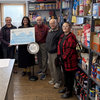Retail, arts hub pitched for 18 South Main
VOORHEESVILLE — From a museum to a maker space, Voorheesville residents recently offered a number of ideas for what they’d like to see happen to the village-owned late 19th-Century building at 18 South Main Street.
On Nov. 12, some three dozen residents packed the village fire department’s firehouse on Altamont Road for a meeting on the fate of the home of Voorheesville’s first mayor.
Generally speaking, residents favored a multi-use space that serves the community while honoring the village’s heritage. More specifically, ideas offered included the creation of a community hub for events and services, an artisan maker space or co-op gallery, and various retail concepts like a general store or ice-cream shop.
The village acquired the property for $170,000 in January.
The reason for the purchase, Mayor Rich Straut told attendees on Nov. 12, was the need for more public parking to support revitalization of the village’s business district, which the mayor pointed out was an objective established in the 2018 village comprehensive plan.
The initial assumption was that the building would be demolished to create an open parking lot, Straut said, but, upon further inspection, it was determined the building had a “pretty good solid structure,” and was worth saving.
The project already has significant financial backing with $50,000 in village funds and $200,000 in promises from the state, but that money will be gobbled up by mundane yet important necessities including asbestos abatement, building stabilization, and selective demolition.
Straut on Nov. 12 stressed the importance of receiving the state funds early in the project process because that money will act as a lever to secure more funding down the road.
The money effectively validates a project in the eyes of the state and its agencies, attendees were told, signaling there is significant external interest and support. Even the village holding public meetings and gathering feedback contributes to this validation, demonstrating broad community engagement.
For the sake of brevity and simplicity, resident ideas fell into three broad categories: a community and arts hub, a retail and visitor center, and mixed use.
Community and arts hub
This concept envisions the building as a vibrant, multi-purpose center for community gathering, artistic expression, and education. It would be a flexible space designed to serve all age groups, focusing on providing shared resources, programming space, and opportunities for social connection.
Ideas provided by residents included:
— A dedicated space for teens and seniors, a community center;
— A maker space and affordable for-rent artist studios;
— A class and workshop space for activities like pottery or painting;
— A gallery space to showcase and sell work by local artisans;
— Meeting rooms or a small-scale event space; and
— A public tutoring space;
Retail and visitor destination
This concept sees the building as a commercial destination that leverages village history and its location along the rail trail. The focus is on attracting both visitors and residents through distinctive retail and hospitality offerings that enhance the village’s commercial character.
Ideas provided by residents included:
— A multi-vendor market for local producers, home-based businesses, and artisans;
— A historic-themed general store;
— An ice-cream shop, bakery, or café;
— A bookstore/bar concept; and
— A village welcome center with historical displays, event calendars, and information.
Mixed-use
This concept combines a public-facing commercial or community use on the ground floor with a revenue-generating residential unit on the second floor.
This idea was met with a lot of skepticism as the village was leery about the practicality and lawfulness of becoming a landlord. The idea was that the rental-unit income could help offset the long-term maintenance and operational costs of the building.
The timeline for the project is very open-ended, Straut noted, as the village continues to elicit feedback and pursue funding for the project.


